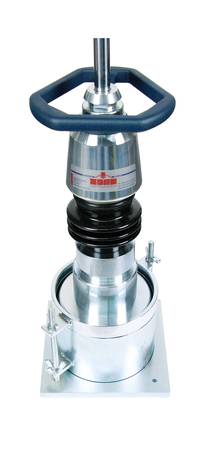ZORN ZFG LAB
With the development of a dynamic plate load test (Lightweight Deflectometer) for use in a Proctor mould it is possible to determine the characteristics that provide a soilspecific assessment background for the indirect determination of the degree of compaction of soils.
Depending on the water content in the Proctor soil sample, values for load-bearing capacity can be determined for decisions about the suitability of existing mineral aggregate because the deformation modulus for these types of soil is not only dependent on the degree of compaction, but also to a significant extent on the water content.
Based on the classic oedometer test during which a soil sample is loaded over an extended period in a cylindrical vessel, the Proctor test with different water contents can be accompanied by a dynamic plate load test. Depending on the portion of fines, the load-bearing capacity of the material tests collapses close to the Proctor maximum.
This test provides information on the optimal water content during laying and the subsequent compaction of the material used. Also the time the base course needs to reach the required Evd value after compaction can be estimated taking into account the course thickness.

Sales international contact
Telephone: +49 3931 25273-116
E-mail: sales(at)zorn-instruments.de






The benefits of performance based quality assurance testing in road construction have become increasingly apparent. To a large part this can be credited to the wider use of LWDs (Lightweight Deflectometers) for measuring the elastic deformation of subgrade and subbase materials.
Over the past decade, ZORN INSTRUMENTS’ Lightweight Deflectometer model ZFG has been the leading field test device for this application in the United States. An ASTM standard was established in 2011 (ASTM E2835 – 11[2015] - Standard Test Method for Measuring Deflections using a Portable Impulse Plate Load Test Device)
Public agencies as well as private consultants in a fast-growing number of US States have acquired ZFG Lightweight Deflectometers and have started to implement their use. Consequently, there is now a requirement to modify existing construction specifications and include LWDs as an option for road construction quality assurance.
Recently completed Transportation Pooled Fund Program Project #TPF-5(285) has addressed this requirement. ZORN INSTRUMENTS now present a first laboratory device for use in LWD testing on Proctor Mold. This device is an adopted version of the known field test instrument. The proposed application is determination of target LWD modulus values in field through a laboratory procedure. As a prototype the ZORN Laboratory LWD reflects the findings and technical recommendations from the TPF project.
Your sincerely, Bernd Zorn mechanical engineer (Diplom-Ingenieur, Germany)

Before starting the LWD testing compact soil sample in a 6-inch mold to desired MC value (moisture content). Use standard compaction energy according. To AASHTO T-99)
- Mount safety collar on Proctor mold rim
- Place ZORN Laboratory LWD on compacted soil
- Release transport lock
- Latch falling weight at upper notch
- Release transport lock and latch falling weight at upper notch
- Switch on electronic control box, push start button and release falling weight
- Results are instantly shown on control box display
- Push print button an print test protocol
ZORN Laboratory Lightweight Deflectometer for 6-inch Proctor mold
Assumed constants:
- μ (Poisson's ratio) 0.5
- f (shape factor) 2
- g (acceleration, gravity) 9.81 m/s²
ZORN LWD parameters:
- M = 17 kg (total mass)
- l = 26.4“ = 0.67 m (rod length)
- m = 5 kg (falling weight)
- h = 14.8“ = 0.375 m (falling height)
- k = 0.306 106 N/m (spring constant)
- R = 3.0” = 75 mm (load plate radius)
- F = 3.54 kN (collision force)
- σ = 200 kPa (soil pressure)
Equations:
Dynamic elasticity modulus: